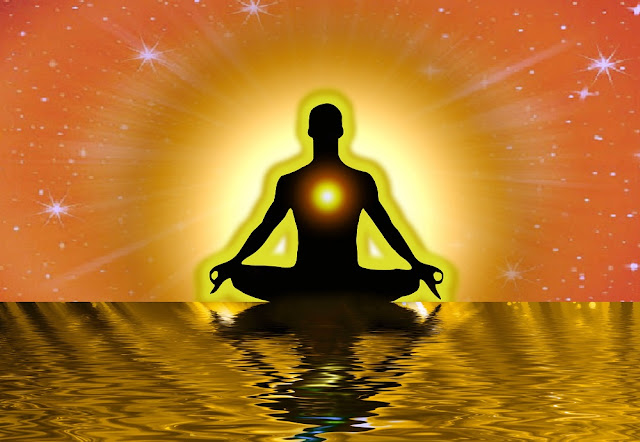 |
| A rare photo taken in a Bangalore photo studio on devotees' insistence |
Three Stages of Meditation
Some persons use a Jyoti (lamp) as a basis for meditation. The lamp reveals the oneness that is the basis of the Unity of the Divine as well as the multiplicity that reflects the manifestations of the Divine. In this method, the experience of bliss does not come quickly. There are three stages in this type of meditation: Uuha (imagining the Form), Bhava (experiencing the Form) and Sakshatkara (seeing It as a Reality). For instance, if one wishes to meditate upon Baba, he first tries to imagine with the dosed eyes the figure of Baba as seen by him earlier. This figure vanishes within a few moments. In experiencing the figure, the process is longer and the impression also lasts longer. In this process, one starts envisaging the figure from head to foot and from the feet upwards. Gradually, by this process the picture of Baba gets firmly implanted and becomes an inner reality. While the imagining process gives only a momentary glimpse, the experiencing method leads to the complete identification of the seeker with the Divine Form. Awareness of the Divine results in oneness with the Divine (Brahmavid Brahmaiva Bhavati). When we are experiencing the Divine Form, what is happening to our mind? The mind experiences every part of the Lord from head to foot and ultimately becomes one with the Form. It is the process of identification of the mind with the Divine form that constitutes true meditation. Meditation is not merging the Form in the mind. It is merging the mind in the Form so that the mind as such does not exist.
Consistent Efforts are Necessary
While sitting for meditation in a group, one should not be in contact with anyone else. This is highly important. Meditation is like the process of electrifying a wire. If a live wire comes in contact with something, it will produce a shock. During meditation, spiritual energy is generated. How is this energy lost? It is lost through finger nails and the hairs on one's body. This was the reason why the ancient Yogis (spiritually advanced persons) allowed their nails and hairs to grow freely. Spiritual energy has to be conserved by all possible means. The Rishis (saints) practiced silence to conserve the energy lost through speech.
Do not develop too close a relationship with one another. Such a close relationship results in intimate friendship which produces mutual obligations and expectations. From these arise the sense of ego. When expectations are not fulfilled, resentment emerges. When they are realised, the ego gets inflated. Either way, the consequences of entertaining desires are undesirable. When resentment grows, the discriminating power is weakened. One loses control over his tongue and indulges in all kinds of abuse. Abuse leads to sinful conduct. The whole process is generated by excessive association with one another.
Young people tend to let their minds wander hither and thither. They should concentrate on their studies and should not give their minds a free rein. They should reduce their worldly concerns and devote some time to meditation every morning and evening. This will help to purify their minds and set them on the road to Divinity. Like the river losing itself in the ocean, the mind must merge in the Divine. Then, there will be no mind at all. That blissful state can be realised only through the path of Love. Love is God. Live in Love. Realisation of the power of Love is the true aim of meditation. That Love is utterly selfless and is dedicated to the Divine. Methods of meditation are many, but goal is one.
In the practice of meditation, it should be realised that all cannot follow the same pattern or method. It varies according to the evolution and circumstances of each individual and his or her capacity and earnestness. Some worship the Supreme as the Universal Mother. Some look upon the Almighty as Father. Some regard God as the Supreme Friend. Some devotees approach the Divine as the Beloved or the Master. Jayadeva, Gauranga and Ramakrishna Paramahamsa belonged to the last mentioned category. They did not practise meditation. They felt the presence of God everywhere. Where could they go for meditation? Such was their experience. To the true Sadhaka evidence of the omnipresence of God can be found everywhere. By merely closing one's eyes, one does not engage in meditation. One must feel one's unity with God in one's inner being.
Prayer is for the mind what food is for the body. Just as wholesome food gives health and strength to the body, prayer purifies the mind and strengthens the spirit. If Bhajans (devotional songs) are done in an ostentatious manner, the ego gets bloated. Young people must proceed from Tamas (the darkness of ignorance) to Tapas (spiritual penance). They must be steadfast in pursuing whatever they take up. There is no meaning in doing meditation for two days and giving it up on the third day. Meditation must become an integral part of one's life. Along with it, all the knowledge and skills required for one's profession or vocation should be acquired.


Om Sri Sai Ram.
ReplyDeleteThanks for the precious gems
om sri sai ram
ReplyDeleteOM SAI RAM:)
ReplyDelete